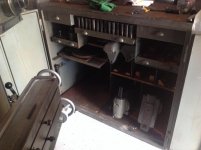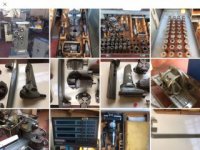Hello,
I'm hoping that I've pressed the right buttons to find the Deckel forum at large, never done this before. There seem to be Deckel owners all over the world and as I've just bought an FP1 I'm wondering if there are any near me in Devon, UK. My machine is from 1969 and I bought it from the original owner with the manufacturers cupboard full of good accessories and 3axis Accurite dro. It seems to be lightly used and in excellent condition but not used for some time, maybe years.
My problem at the moment is that it had a collet in the horizontal spindle very tightly gripped onto a drill. I loosened it ok and took out the drill but can't free the adaptor. I thought a tap with a leather mallet should do the job but it's stuck. Is there something I don't know? Is it threaded as well? Can't see anything on the drawings and I really don't want to use too much force.....!
Any ideas?
I'm hoping that I've pressed the right buttons to find the Deckel forum at large, never done this before. There seem to be Deckel owners all over the world and as I've just bought an FP1 I'm wondering if there are any near me in Devon, UK. My machine is from 1969 and I bought it from the original owner with the manufacturers cupboard full of good accessories and 3axis Accurite dro. It seems to be lightly used and in excellent condition but not used for some time, maybe years.
My problem at the moment is that it had a collet in the horizontal spindle very tightly gripped onto a drill. I loosened it ok and took out the drill but can't free the adaptor. I thought a tap with a leather mallet should do the job but it's stuck. Is there something I don't know? Is it threaded as well? Can't see anything on the drawings and I really don't want to use too much force.....!
Any ideas?






